Reported by:
Khoo Xin Yi Sr1ScA
Goh Li Lian Sr2ScA
With war comes its aftermath, and the environment is far from spared.
On the 7th of June 2022, Kuen Cheng High School Environmental Club organized a webinar titled The Impact of War to the Environment. Our Speaker, Chang Qian Hung, from Senior Middle Three, began by saying that this would be a knowledge-based talk, and promised ample captivating real-life examples to be shared throughout the webinar.
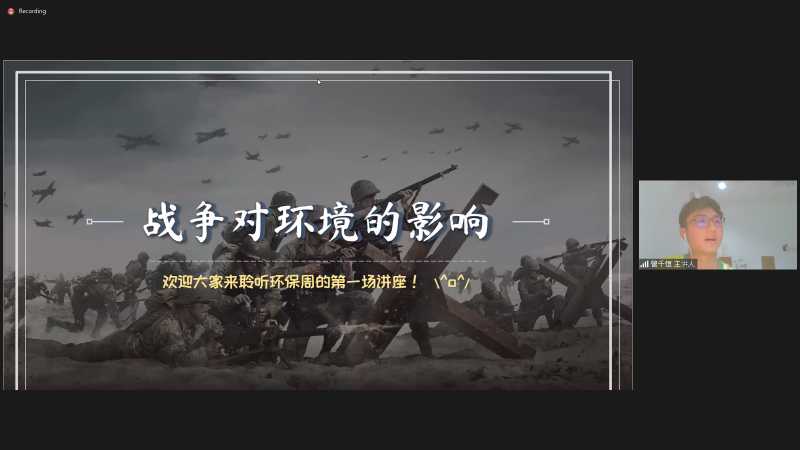
The Impact of War to the Environment
Qian Hung defined war as a conflict involving countries, regimes, political entities and human communities. It is characterized by violence, destruction and death. In his slides, he explained the evolution of war weaponry starting from the use of stones and sticks, to swords and shields, to bows and arrows, and finally to guns, cannons and atomic bombs.
Some real-life examples were brought up, like the first-ever war in human history which took place on the Nile River Civilisation in BC 3150, and the war-torn backdrops of World War I, World War II and the Russia-Ukraine War. A brief Q&A session ensued, whereby the Speaker asked the question “What are the consequences of war?”. The audience came up with different answers consisting of the inevitable economic crisis, supply chain shortages, environmental pollution, ecosystem imbalance, widespread diseases and ultimately, loss of lives and property.
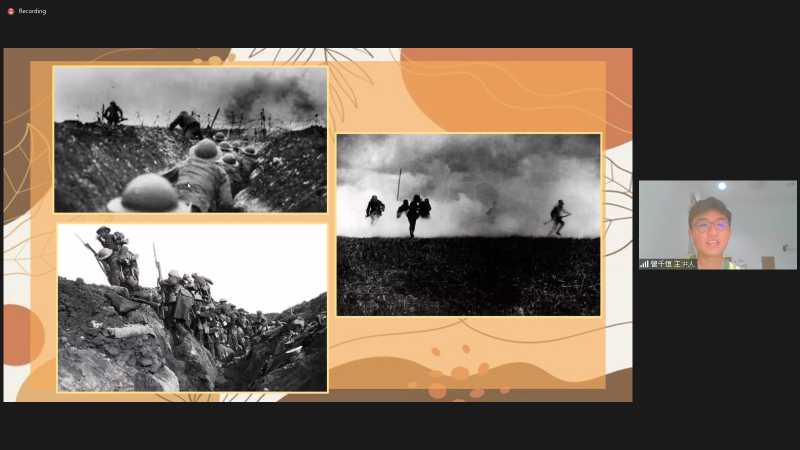
The First World War
Moving on, our Speaker explained that throughout the preparation process for war, fatal consequences are inflicted upon water, land and air. Water is polluted by toxic chemical substances and ammunition remains. Land is crippled by the setting up of war camps and chemical testing areas. One such example is the nuclear testing sites at Bikini Atoll which involved the detonation of 23 nuclear weapons by the United States between 1946 and 1958. The explosion yielded 15 megatons, more than two times of what was expected. On the other hand, air quality is damaged by chemical emissions released into the atmosphere.
During the actual wartime, water-related consequences are correlated with biological weapons producing toxic chemicals, conflicts over natural resources, and crude oil leaks damaging underwater ecosystems. One such example is Unit 731, a notorious branch of the Imperial Japanese Army that conducted lethal experiments on Chinese civilians in the 1930s and 40s to develop biological weapons.

The Second World War
Similarly, the aftermath on land consists of buildings being demolished, rubble and smoke clouds clogging up streets, potholes, and oil spills from military equipment polluting the soil. During his explanation, Qian Hung mentioned the Vietnam War, wherein American soldiers sprayed toxic Agent Orange chemicals which crippled trees and disfigured the future Vietnamese children. In the context of air pollution, it is caused by tanks emitting toxic gasses and oil rigs catching fire, bringing about global warming. One such example is the Gulf War, wherein the Iraq forces destroyed petrol facilities during their retreat, which caused severe acid rain comprising black and greasy rainwater.
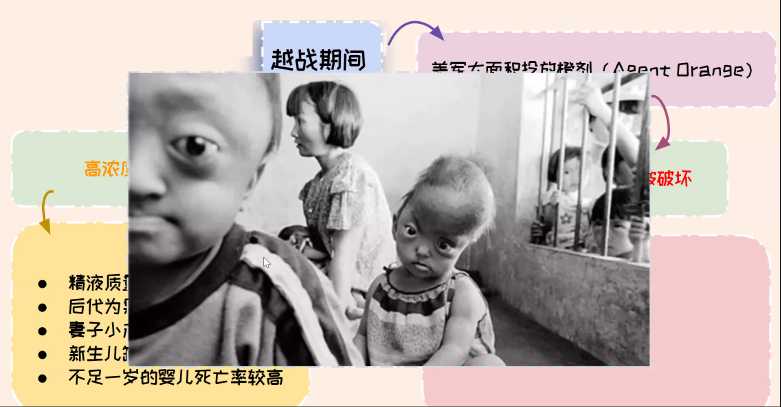
Disfigured Children as Caused by Agent Orange Chemicals
Sim Chong You, from Jr3Z(6), was the Speaker up next, explaining the environmental impacts found after a war. In terms of water pollution, chemical spills and abandoned artillery take the cake, especially in the Baltic Sea, which is known as the most polluted ocean in the world. On land, the destruction caused after a war may litter entire cities in debris, rubble, broken tiles and splinters. Such destruction was said to happen especially after bombings and airstrikes, like the ones that happened in Mosul (Iraq), Yemen, Nagasaki (Japan), Hiroshima (Japan) etc. These bombs caused air pollution too, such as depleted uranium bombs that release poisonous gas, which may cause harmful effects in child development as well.
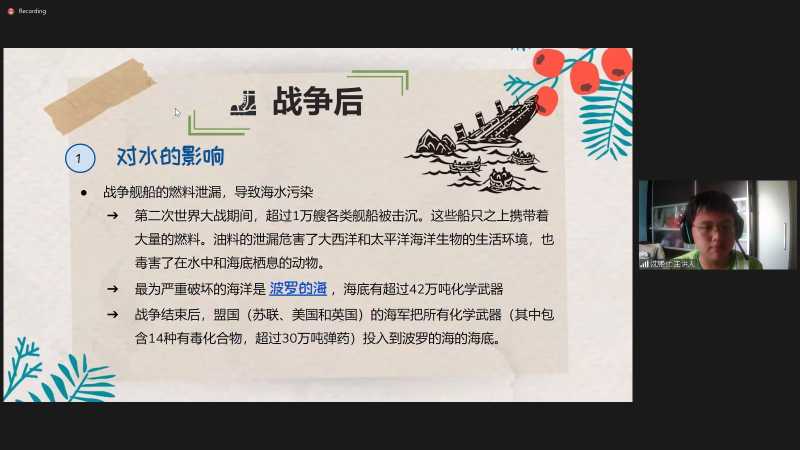
Water Pollution After War
Chong You also explained how war impacts the lives of living organisms. For starters, nuclear weapon emissions cause acid rain, and acid rain has a lower pH level than needed, which causes plants to die. Infestations could also be caused by animals that follow soldiers to different countries. This leads to an imbalance in local ecosystems and could endanger other species. Along with that, some countries were said to have destroyed whole forests using chemical gasses in order to see enemy soldiers better in cleared land. The speaker also mentioned that illegal poaching and logging was on the rise during warfare.
Thereafter, Chong You talked about organizations that helped to reduce the damage done during war. He talked about landmine removal squads in Vietnam, where they would either check for mines manually or train rats to detect the chemicals in landmines. Aside from that, he also brought up the United Nations, a global organization that helped countries like Iraq and Baghdad reduce pollution and cyanides found after war. They also passed several laws stating that chemical products could only be used under certain discretions.
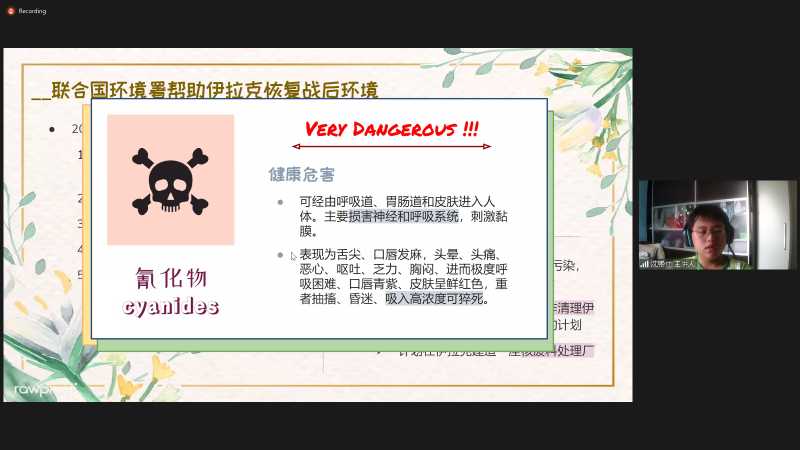
The Danger of Cyanides
Apart from that, the participants were also given a real-life example of how war can impact the environment. Chong You brought up the on-going Russia-Ukraine War where several states in Ukraine have been heavily polluted due to the invasions. States like Chernobyl and Brovary have been reported to hold high levels of radiation, along with oil spills in several other areas. Due to river pollution, most citizens do not even have clean drinking water. The speaker also talked about how over 20 national conservatories and protected habitats have been destroyed over the course of the war. Carbon emissions and forest fires are among the list of air pollutants as well. It was stated that the weather in Ukraine increased by approximately 0.7℃, and that rain levels have been decreasing, along with the loss of many fertilized lands.
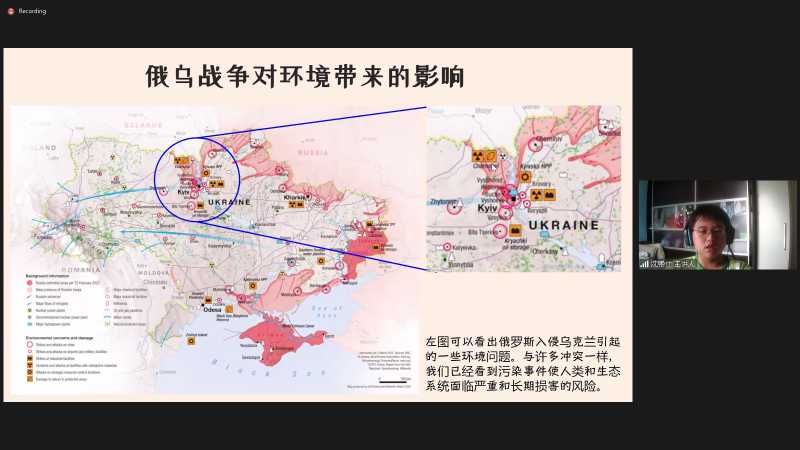
Russia-Ukraine War Environmental Impacts
Before ending off the webinar, Chong You briefly spoke about some additional information, including the reasons war still happens even though it causes this much destruction. Besides that, he explained that any countries involved in the war are the countries that are responsible for cleaning up the mess. They will send unarmed “clean-up” soldiers to clear the rubble and debris. Some citizens were also said to have created recycled art out of empty bomb shells or metal barrels.
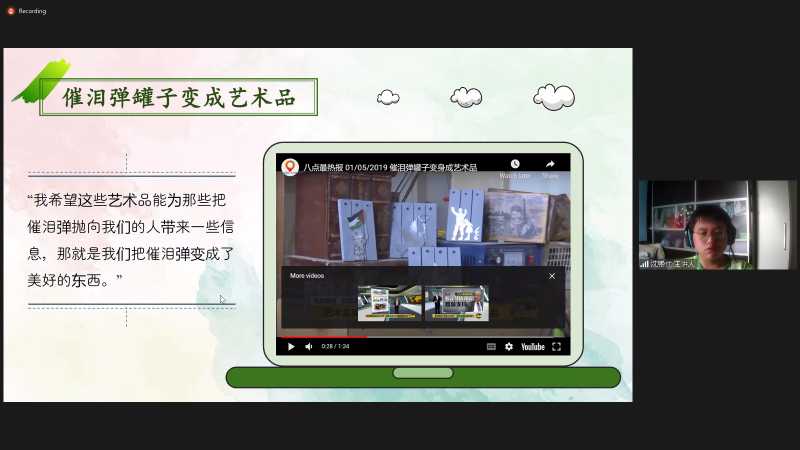
Recycled Art made of Bomb Shells
